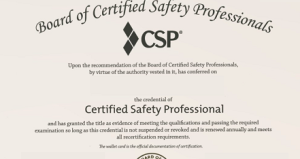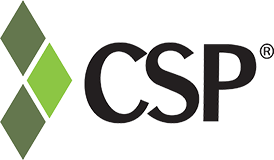CERTIFIED SAFETY PROFESSIONAL (CSP)
Certified Safety Professional (CSP) is a certification offered by the Board of Certified Safety Professionals (BCSP). The CSP is accredited in the United States by the National Commission for Certifying Agencies and internationally by the International Organization for Standardization/International Electro technical Commission (ISO/IEC 17024).
Certified Safety Professionals (CSP) are persons who perform at least 50% of professional level safety duties, including making worksite assessments to determine risks, assessing potential hazards and controls, evaluating risks and hazard control measures, investigating incidents, maintaining and evaluating incident and loss records, and preparing emergency response plans. Other duties could include hazard recognition, fire protection, regulatory compliance, health hazard control, ergonomics, hazardous materials management, environmental protection, training, accident and incident, investigations, advising management, record keeping, emergency response, managing safety programs, product safety and/or security (as defined by BCSP).
This course is suitable for Safety Managers, Directors, Engineer, Officers and all Health and safety professionals who wants to develop their career (must meet the eligibility requirements from BCSP).
ELIGIBILITY CRITERIA:
All individuals applying for the CSP must have,
- A bachelor’s Degree
- 4 years of safety experience where safety is at least 50%, preventative, professional level with breadth and depth of safety duties.
HOLDING A BCSP APPROVED CREDENTIAL AS LISTED BELOW:
- Associate Safety Professional (ASP), Graduate Safety Practitioner (GSP), Transitional Safety Practitioner (TSP), Certified Industrial Hygienist® (CIH®)
- Chartered Member of the Institution of Occupational Safety and Health (CMIOSH)
- Canadian Registered Safety Professional (CRSP)
- CP-12 Professional Certificate in Safety and Occupational Health, U.S. Army Combat Readiness Center (ACRC)
- Certified Safety Engineer (CSE), as administered by the State Administration of Work Safety (SAWS), People’s Republic of China (PRC)
- Master in Occupational Safety and Health, International Training Centre of the International Labor Organization (ITC-ILO)
- Member in the Institute of Safety Professionals of Nigeria (MISPN)
- NEBOSH National or International Diploma in Occupational Health and Safety
- Professional Member of the Singapore Institution of Safety Officers (SISO)
- Diploma/Certificate in Industrial Safety as issued by the State Government Departments/Boards of Technical Education, Government of India

COURSE SYLLABUS:
CSP Exam determines your competency in 9 domains hence our CSP course covers,
- Advanced Science and Math
- Management Systems
- Risk Management
- Advanced Safety Concepts
- Emergency Preparedness, Fire prevention and Security
- Occupational Health and Ergonomics
- Environmental Management System
- Training/Education
- Law and Ethics
EXAMINATION & CERTIFICATION:
The CSP examination is a computer based test, contains 200 multiple choice question with four possible answers and only one correct answer. You will have 5.5 hours to complete the CSP examination. Examinations are closed book, and accessing external reference materials during your examination is not permitted.
RECERTIFICATION:
CSPs must remain up to date with changes in professional practice by earning 25 recertification points every five years.
Is CSP certification worth it?
Safety Certification in Europe
Internationally, other countries have set up similar programs. In the UK the highest professional standing is that of a chartered safety and health practitioner or fellow of the International Institute of Risk and Safety Management. The standards are maintained by both the UK’s largest body for safety professionals Institution of Occupational Safety and Health and the International Institute of Risk and Safety Management. Like North American safety professional programs, to achieve these grades the applicant must be professionally qualified and have relevant experience. Continuing professional development is also a strong requirement of both memberships. The International Institute of Risk and Safety Management also offered Recognized Safety Professional (not to be confused with ‘registered safety practitioners’ of OSHCR) these honorary post nominal letters given by to recognized safety practitioners.







